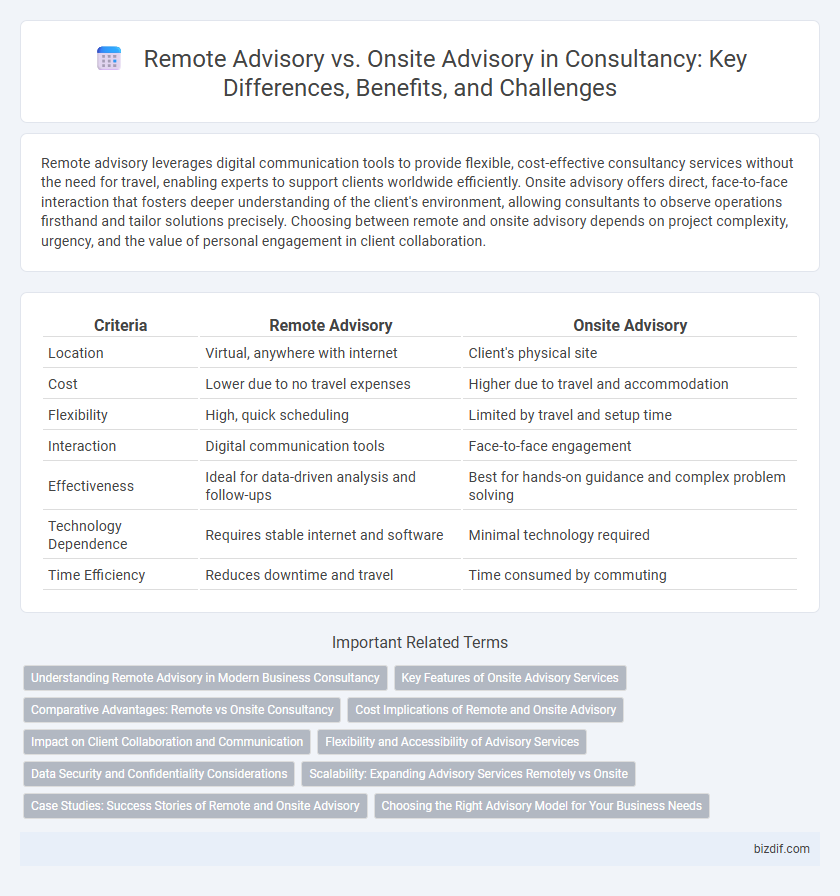Remote advisory leverages digital communication tools to provide flexible, cost-effective consultancy services without the need for travel, enabling experts to support clients worldwide efficiently. Onsite advisory offers direct, face-to-face interaction that fosters deeper understanding of the client's environment, allowing consultants to observe operations firsthand and tailor solutions precisely. Choosing between remote and onsite advisory depends on project complexity, urgency, and the value of personal engagement in client collaboration.
Table of Comparison
| Criteria | Remote Advisory | Onsite Advisory |
|---|---|---|
| Location | Virtual, anywhere with internet | Client's physical site |
| Cost | Lower due to no travel expenses | Higher due to travel and accommodation |
| Flexibility | High, quick scheduling | Limited by travel and setup time |
| Interaction | Digital communication tools | Face-to-face engagement |
| Effectiveness | Ideal for data-driven analysis and follow-ups | Best for hands-on guidance and complex problem solving |
| Technology Dependence | Requires stable internet and software | Minimal technology required |
| Time Efficiency | Reduces downtime and travel | Time consumed by commuting |
Understanding Remote Advisory in Modern Business Consultancy
Remote advisory in modern business consultancy leverages digital communication tools to provide strategic guidance without physical presence, allowing consultants to access diverse markets and clients globally. This approach enhances flexibility, reduces travel costs, and accelerates decision-making processes by enabling real-time collaboration through video conferencing, cloud platforms, and virtual data rooms. Remote advisory supports scalable business solutions tailored to dynamic market demands, fostering innovation and maintaining continuity amid disruptions like global pandemics or geopolitical uncertainties.
Key Features of Onsite Advisory Services
Onsite advisory services provide direct, face-to-face interaction that enhances communication and fosters a deeper understanding of client needs. These services allow consultants to conduct hands-on assessments, observe operational processes in real time, and offer immediate, tailored solutions. Key features include customized workshops, onsite team collaboration, and real-time troubleshooting that drive efficient, context-specific improvements.
Comparative Advantages: Remote vs Onsite Consultancy
Remote consultancy offers clients flexible scheduling and access to a broader range of specialized experts without geographical constraints, enhancing cost-efficiency and rapid response times. Onsite advisory provides direct, face-to-face interaction, fostering stronger client relationships and enabling real-time observation of operational dynamics that improve customized solution development. Both models complement each other, with remote consultancy excelling in scalability and technology integration, while onsite consultancy delivers hands-on engagement and immediate problem-solving.
Cost Implications of Remote and Onsite Advisory
Remote advisory significantly reduces costs by eliminating travel expenses, accommodation, and onsite logistical arrangements, leading to lower overall consultancy fees. Onsite advisory often incurs higher direct costs due to travel, lodging, and time spent commuting, but may provide added value through face-to-face interaction and immediate problem-solving. Organizations must weigh these cost implications against the potential benefits of in-person engagement when choosing between remote and onsite advisory services.
Impact on Client Collaboration and Communication
Remote advisory leverages digital tools to facilitate real-time communication and broadens access to expert insights regardless of location, enhancing client collaboration through flexible scheduling and instant information sharing. Onsite advisory fosters deeper relationship-building and trust via face-to-face interactions, enabling nuanced understanding of client environments and immediate feedback loops. Both approaches impact communication effectiveness differently: remote advisory prioritizes convenience and scalability, while onsite advisory emphasizes personalized engagement and contextual awareness.
Flexibility and Accessibility of Advisory Services
Remote advisory offers unparalleled flexibility, allowing clients to access expert guidance anytime and from any location, which significantly enhances convenience for busy schedules. Onsite advisory, while less flexible, provides the advantage of direct, face-to-face interaction that can foster deeper understanding and tailored solutions. Combining both approaches can optimize accessibility, catering to diverse client needs and ensuring continuous support without geographic limitations.
Data Security and Confidentiality Considerations
Remote advisory leverages secure cloud platforms with end-to-end encryption protocols to ensure data security and confidentiality during virtual consultations, minimizing risks associated with physical data breaches. Onsite advisory enables direct control over sensitive information through localized data storage and access restrictions, reducing exposure to network vulnerabilities inherent in remote environments. Both approaches require rigorous compliance with industry standards such as ISO 27001 and GDPR to safeguard client data and maintain confidentiality.
Scalability: Expanding Advisory Services Remotely vs Onsite
Remote advisory enables rapid scalability by leveraging digital platforms to serve diverse clients without geographic limitations, reducing travel time and operational costs. Onsite advisory, while offering personalized, face-to-face interaction, often encounters scalability constraints due to resource availability and logistical challenges. Emphasizing cloud-based tools and virtual collaboration enhances efficiency in expanding remote advisory services, making it a preferred model for scalable consultancy growth.
Case Studies: Success Stories of Remote and Onsite Advisory
Case studies reveal that remote advisory enhances client access to specialized expertise, leading to a 30% reduction in project turnaround time for global firms. Onsite advisory drives stronger stakeholder engagement and deeper contextual insights, resulting in a 25% increase in client satisfaction scores across complex infrastructure projects. Both remote and onsite advisory models demonstrate distinct success metrics, with remote solutions excelling in scalability and onsite services enhancing relational trust.
Choosing the Right Advisory Model for Your Business Needs
Selecting the appropriate advisory model hinges on your business requirements, operational complexity, and budget constraints. Remote advisory offers flexibility and cost-efficiency through virtual consultations, ideal for businesses seeking quick, scalable support without geographical limitations. Onsite advisory provides hands-on expertise and direct interaction, essential for projects demanding deep collaboration and on-ground insights.
Remote advisory vs Onsite advisory Infographic

 bizdif.com
bizdif.com